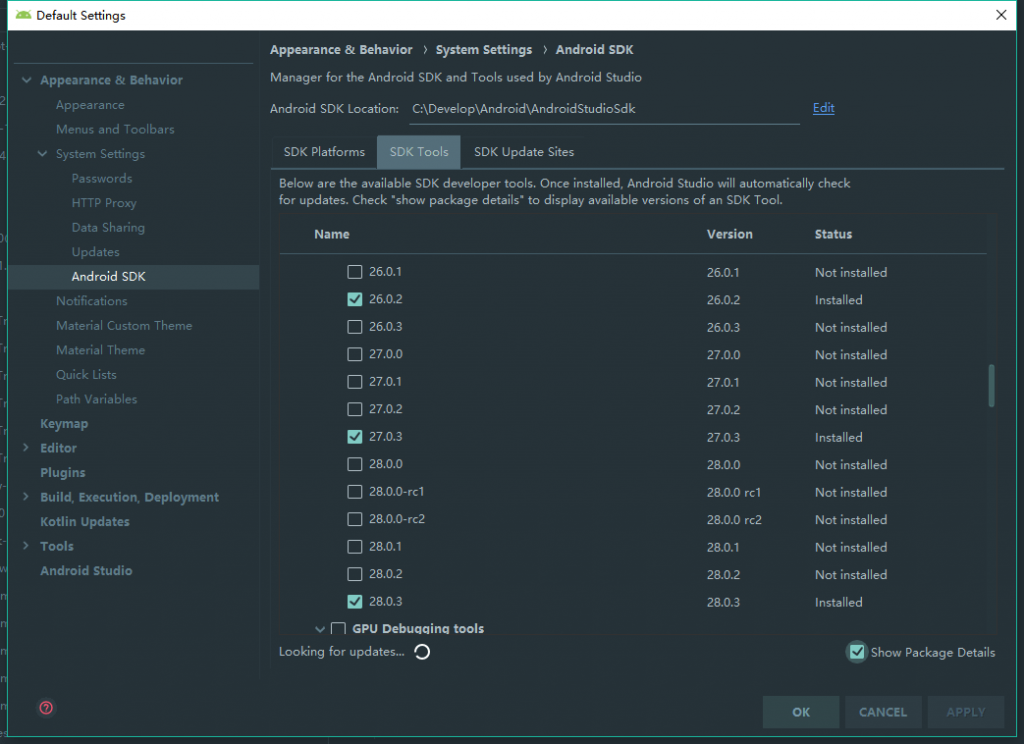在Android的module级build.gradle里,有着为数不少的Version,其中最重要的有以下几个:compileSdkVersion、buildToolsVersion、minSdkVersion、targetSdkVersion、maxSdkVersion。很多人在对这些版本号进行设定的时候,其实自己脑子里也是迷迷糊糊、混混沌沌的,并不明白它们到底代表了什么。也许你还没因为它们掉坑里,但是理解这几个字段的作用其实还是很有必要的。本文大量引用了Android Developer(即Android官网)的资料,有兴趣的朋友也可以自行去官网进行学习。下面我们就来看看这么多的Version到底代表了什么,有什么区别,以及最终该如何选择不同的版本。
compileSdkVersion
compileSdkVersion specifies the Android API level Gradle should use to compile your app. This means your app can use the API features included in this API level and lower.
compileSdkVersion指定了Gradle编译你的App时使用的Android API版本,你的App可以使用该版本或者更低版本的API特性。简单来说,如果你用了一些比较新的API特性,那么你的compileSdkVersion就不能低了。通常它应该是Android最新的稳定版本。比如Android Pie(9.0)已经正式发布,那么我们的compileSdkVersion最好直接提升到28(即9.0对应的版本号)。
buildToolsVersion
buildToolsVersion specifies the version of the SDK build tools, command-line utilities, and compiler that Gradle should use to build your app. You need to download the build tools using the SDK Manager.
buildToolsVersion制定了Gradle在编译App时使用的SDK build tools、命令行、程序、编译器等的版本,这些都是通过SDK Manager下载的。它的值实际上是一个字符串,在Android Studio里我们通过Tools->SDK Manager,然后点选“SDK Tools”并勾选“Show Package Details”就能看到本地电脑已经下载的SDK Build-Tools的版本。
一般来说,选择跟compileSdkVersion同一个大版本下的最新稳定版本即可,如下图里我已经下载了这么多版本的Build-Tools,在新开发App时我会选择28.0.3版本。

minSdkVersion
An integer designating the minimum API Level required for the application to run. The Android system will prevent the user from installing the application if the system's API Level is lower than the value specified in this attribute. You should always declare this attribute.
Caution: If you do not declare this attribute, the system assumes a default value of "1", which indicates that your application is compatible with all versions of Android. If your application is not compatible with all versions (for instance, it uses APIs introduced in API Level 3) and you have not declared the proper minSdkVersion, then when installed on a system with an API Level less than 3, the application will crash during runtime when attempting to access the unavailable APIs. For this reason, be certain to declare the appropriate API Level in theminSdkVersion attribute.
minSdkVersion指定了App运行所需最低的API级别,比如你设置它为23(Android 6.0),那么该App不能在低于Android6.0版本的设备上安装。从理论上来说,如果你设置minSdkVersion为1,则可以最低兼容到最早的Android版本——然而,这就意味着你要为老设备的兼容做大量的工作,显然并不可取,毕竟从统计上来说已经没有人用那么老的设备了。
一般来说,我们通过一些统计结果,以及本公司App的用户分析,来决定最低兼容版本。
根据Google Play的统计,截止到2018年10月26日,使用Android 4.4及以上版本的设备大概占了96.5%,而5.0及以上的则占了接近89%,所以最低版本兼容到4.4就基本上问题不大了。实际上一些老设备的活跃度会比较差,从这个角度考虑,直接从5.0开始做兼容也是可以的。
而用户分析则指的是,App面向的用户的特征。比如用户群体主要是30岁左右的白领,那么这些用户普遍换手机的频率较高,基本上都能追着比较新的Android版本,那么minSdkVersion设置的比较高也问题不大;而如果用户群体面向50甚至60岁以上的中老年人,这些用户对换手机、升级系统不是很感冒,所以有必要把minSdkVersion设置的低一些。
记住,千万不要忘了设置minSdkVersion,如果你不设置,那么就变成了默认值:1,然后你使用的任何在Android 1.0之后才加入的特性,在1.0上运行就崩溃了。
targetSdkVersion
An integer designating the API Level that the application targets. If not set, the default value equals that given to minSdkVersion.
This attribute informs the system that you have tested against the target version and the system should not enable any compatibility behaviors to maintain your app's forward-compatibility with the target version. The application is still able to run on older versions (down to minSdkVersion).
As Android evolves with each new version, some behaviors and even appearances might change. However, if the API level of the platform is higher than the version declared by your app's targetSdkVersion, the system may enable compatibility behaviors to ensure that your app continues to work the way you expect. You can disable such compatibility behaviors by specifying targetSdkVersion to match the API level of the platform on which it's running. For example, setting this value to "11" or higher allows the system to apply a new default theme (Holo) to your app when running on Android 3.0 or higher and also disables screen compatibility mode when running on larger screens (because support for API level 11 implicitly supports larger screens).
There are many compatibility behaviors that the system may enable based on the value you set for this attribute. Several of these behaviors are described by the corresponding platform versions in the Build.VERSION_CODES reference.
To maintain your application along with each Android release, you should increase the value of this attribute to match the latest API level, then thoroughly test your application on the corresponding platform version.
targetSdkVersion完全可以按照它的字面意思去理解:目标sdkVersion。如果没有设置,则默认值为minSdkVersion。当你设置了targetSdkVersion的时候,表示你已经充分测试过了你的App在该目标版本的运行情况,系统不应该启用任何兼容性行为来保持你的App与目标版本的向前兼容性。
如果系统的API级别高于应用的目标版本,则系统会启用兼容性行为来确保应用在更高版本系统上的运行。这一点相信做Android开发时间比较久的人都很理解了,只要你写的程序比较规矩,没有太多的官方推荐外的行为,那么一个老版本的应用放在几年后的Android新设备上依然能顺利运行,只不过相当多的开发者(尤其是国内的)并不是很遵守规范罢了。
maxSdkVersion
对于这个属性,我都懒得贴官方的英文文档了,简单来说,它指定了应用所能运行的系统的最高版本。比如你把你的应用的maxSdkVersion设定为26(Android 8.0),则它无法安装在27以及更高版本的系统中。如果原来安装在26的设备里,后来设备系统升级到27或28,则该程序不能运行。总而言之,我实在是想不到任何理由去设定maxSdkVersion,所以你不应该给你的应用设定maxSdkVersion——除非你能找到说服自己的理由,但有什么理由不兼容更高的版本和更新的设备呢?
总结:
- maxSdkVersion直接放弃。
- minSdkVersion根据不同版本占有率和应用面向用户的群体特征来安排。
- targetSdkVersion和compileSdkVersion一般都直接用最新的稳定版本即可。
- buildToolsVersion则使用跟compileSdkVersion大版本相同的最新稳定小版本。

评论